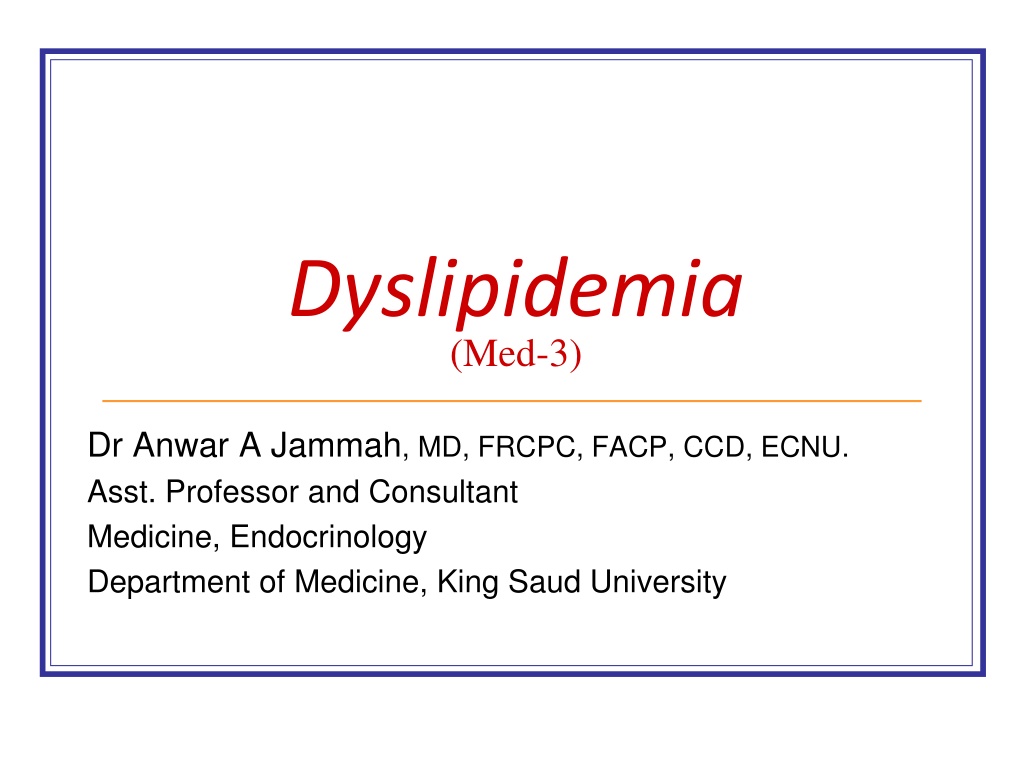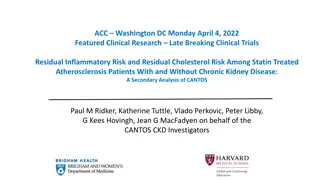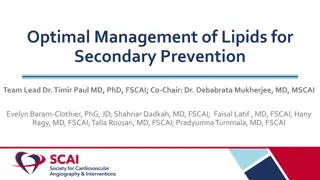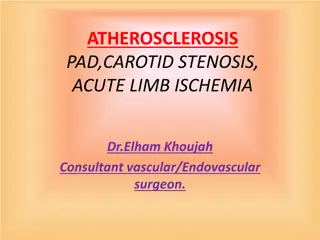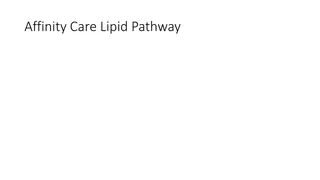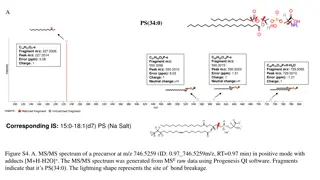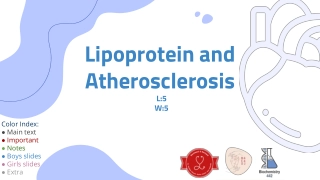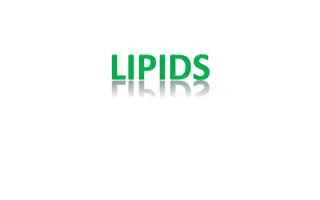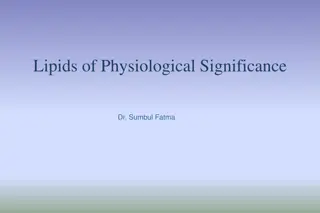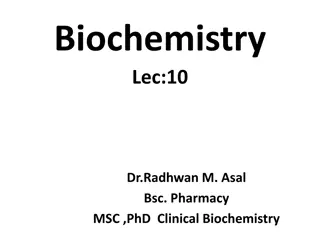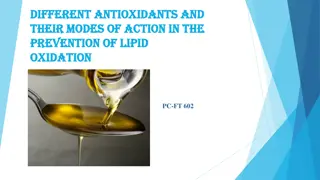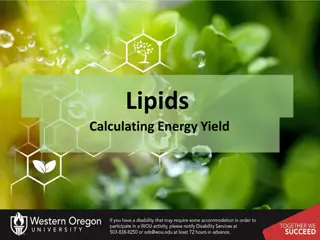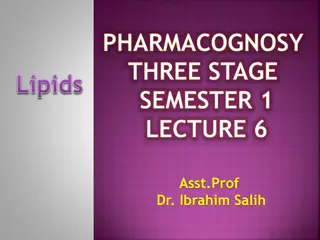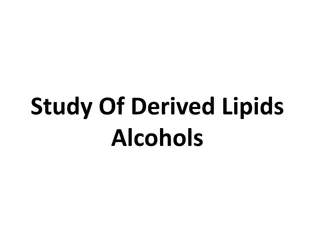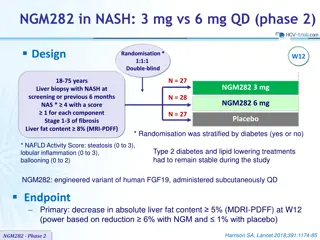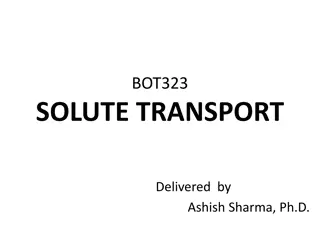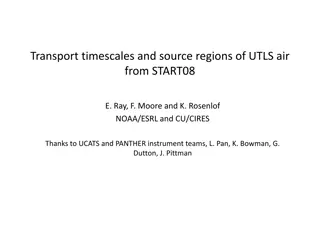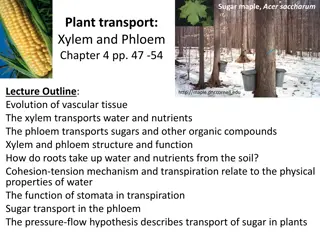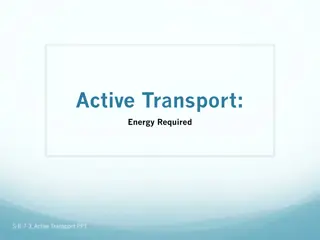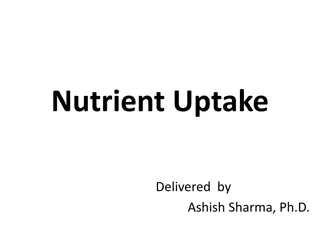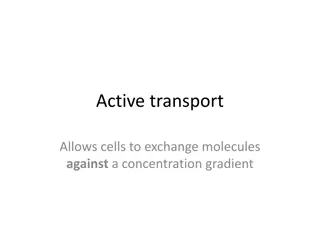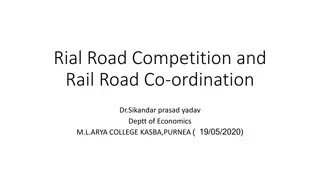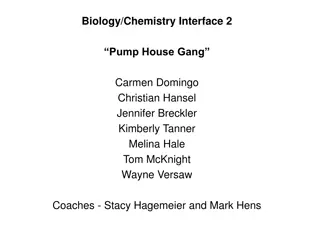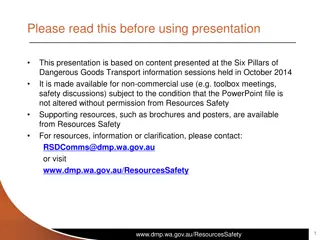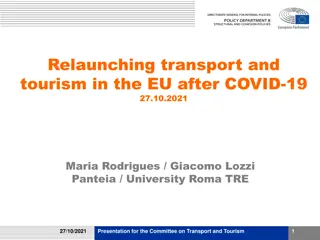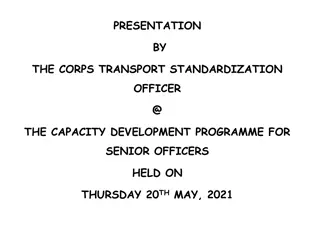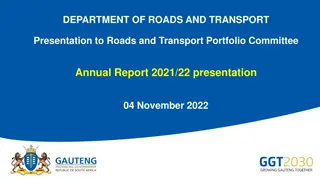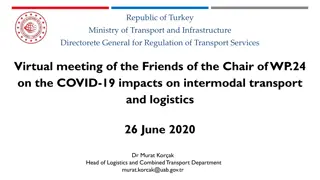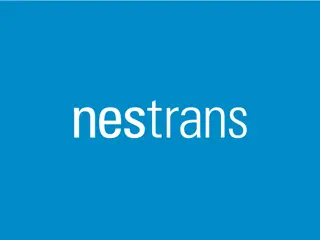Understanding Dyslipidemia and Lipid Transport in Atherosclerosis
Dyslipidemia is characterized by abnormal levels of lipids in the blood, leading to atherosclerosis. Lipid transport mechanisms play a crucial role in the formation and progression of atheromas in artery walls. Chylomicrons carry fats from the intestine to the liver, where they are processed into LDL, which transports fats and cholesterol to body cells. HDL then removes cholesterol from atherosclerotic plaques, reducing the risk of heart disease. Atherogenic particles, such as VLDL and LDL, contribute to plaque buildup. Understanding these processes is essential for managing dyslipidemia and preventing cardiovascular complications.
Download Presentation

Please find below an Image/Link to download the presentation.
The content on the website is provided AS IS for your information and personal use only. It may not be sold, licensed, or shared on other websites without obtaining consent from the author. Download presentation by click this link. If you encounter any issues during the download, it is possible that the publisher has removed the file from their server.
E N D
Presentation Transcript
Dyslipidemia (Med-3) Dr Anwar A Jammah, MD, FRCPC, FACP, CCD, ECNU. Asst. Professor and Consultant Medicine, Endocrinology Department of Medicine, King Saud University
Lipid Transport LPL/Apo C2 Rader DJ, Daugherty, A Nature 2008; 451:904-913
The story of lipids Chylomicrons transport fats from the intestinal mucosa to the liver In the liver, the chylomicrons release triglycerides and some cholesterol and become low-density lipoproteins (LDL). LDL then carries fat and cholesterol to the body s cells. High-density lipoproteins (HDL) carry fat and cholesterol back to the liver for excretion.
The story of lipids (cont.) When oxidized LDL cholesterol gets high, atheroma formation in the walls of arteries occurs, which causes atherosclerosis. HDL cholesterol is able to go and remove cholesterol from the atheroma. Atherogenic cholesterol LDL, VLDL, IDL
Lipid Transport LPL/Apo C2 Rader DJ, Daugherty, A Nature 2008; 451:904-913
Atherogenic Particles MEASUREMENTS: VLDL VLDLR IDL LDL Small, dense LDL TG-rich lipoproteins
HDL and Reverse Cholesterol Transport Bile A- I A-I FC CE LCAT CE FC FC FC CE ABCA1 SR-BI Nascent HDL Macrophage Liver Mature HDL
Plasma lipoproteins Athero- genicity Type Source Major lipid Apoproteins ELFO A-I, B-48, C-I, C-III, E no Chylomicrons Gut Dietary TGs (pancreatiti s) mobility B-100, E, C- II, C-III, Endogenous TGs + VLDL Liver Pre- Slow pre- B-100, C-III, E + IDL VLDL remnant Ch esters, TGs +++ LDL VLDL, IDL Ch esters B-100 anti- A-I, A-II, C-II, C-III, D, E HDL Gut, liver Ch esters, PLs atherogenic
Hereditary Causes of Hyperlipidemia Familial Hypercholesterolemia Codominant genetic disorder, coccurs in heterozygous form Occurs in 1 in 500 individuals Mutation in LDL receptor, resulting in elevated levels of LDL at birth and throughout life High risk for atherosclerosis, tendon xanthomas (75% of patients), tuberous xanthomas and xanthelasmas of eyes. Familial Combined Hyperlipidemia Autosomal dominant Increased secretions of VLDLs Dysbetalipoproteinemia Affects 1 in 10,000 Results in apo E2, a binding-defective form of apoE (which usually plays important role in catabolism of chylomicron and VLDL) Increased risk for atherosclerosis, peripheral vascular disease Tuberous xanthomas, striae palmaris
Fredrickson classification of hyperlipidemias PhenotypeLipoprotein(s) Plasma cholesterol Plasma TGs Athero- genicity Rel. freq. Treatment elevated Chylomicrons Norm. to <1% Diet control I pancreatiti s Bile acid sequestrants, statins, niacin Statins, niacin, fibrates IIa LDL Norm. +++ 10% IIb LDL and VLDL +++ 40% <1% Fibrates III IDL +++ Norm. to Niacin, fibrates IV VLDL + 45% + VLDL and chylomicrons Niacin, fibrates to V 5% pancreatiti s
Primary hypercholesterolemias Genetic defect Disorder Inheritance Prevalence Clinical features premature CAD (ages 30 50) TC: 7-13 mM heteroz.:1/500 5% of MIs <60 yr Familial hyper- cholesterolemia LDL receptor dominant CAD before age 18 homoz.: 1/1 million TC > 13 mM Familial defective apo B-100 premature CAD TC: 7-13 mM apo B-100 dominant 1/700 Polygenic hypercholestero lemia multiple defects and mechanisms common 10% of MIs <60 yr premature CAD TC: 6.5-9 mM variable Familial hyper- alphalipoprotein emia less CHD, longer life elevated HDL unknown variable rare
Primary hypertriglyceridemias Genetic defect Disorder Inheritance Prevalence Clinical features hepatosplenomegaly abd. cramps, pancreatitis TG: > 8.5 mM rare LPL deficiencyendothelial LPL recessive 1/1 million Apo C-II deficiency rare abd. cramps, pancreatitis TG: > 8.5 mM Apo C-II recessive 1/1 million unknown enhanced hepatic TG- production Familial hyper- triglyceridemia abd. cramps, pancreatitis TG: 2.3-6 mM dominant 1/100
Primary mixed hyperlipidemias Genetic defect Disorder Inheritance Prevalence Clinical features Apo E Familial dysbeta- lipoproteinemia premature CAD TC: 6.5 -13 mM TG: 2.8 5.6 mM recessive rarely dominant 1/5000 high VLDL, chylo. 1/50 1/100 15% of MIs <60 yr premature CAD TC: 6.5 -13 mM TG: 2.8 8.5 mM unknown Familial combined dominant high Apo B-100
Dietary sources of Cholesterol Type of Fat Main Source Effect on Cholesterol levels Lowers LDL, Raises HDL Olives, olive oil, canola oil, peanut oil, cashews, almonds, peanuts and most other nuts; avocados Corn, soybean, safflower and cottonseed oil; fish Monounsaturated Lowers LDL, Raises HDL Polyunsaturated Whole milk, butter, cheese, and ice cream; red meat; chocolate; coconuts, coconut milk, coconut oil , egg yolks, chicken skin Raises both LDL and HDL Saturated Most margarines; vegetable shortening; partially hydrogenated vegetable oil; deep- fried chips; many fast foods; most commercial baked goods Raises LDL Trans
Causes of Hyperlipidemia Diet Hypothyroidism Nephrotic syndrome Anorexia nervosa Obstructive liver disease Obesity Diabetes mellitus Pregnancy Obstructive liver disease Acute heaptitis Systemic lupus erythematousus AIDS (protease inhibitors)
Secondary hyperlipidemias Disorder VLDL LDL HDL Mechanism VLDL production , LPL , altered LDL Diabetes mellitus LDL-rec. , LPL Hypothyroidism VLDL production Obesity bile secretion , LDL catab. Anorexia - - Apo B-100 LPL LDL- rec. Nephrotic sy LPL , HTGL (inhibitors ) Uremia, dialysis - oestrogen VLDL production , LPL Pregnancy Lp-X Biliary obstruction PBC - - no CAD; xanthomas dep. on dose, diet, genetics Alcohol - chylomicr.
Checking lipids Nonfasting lipid panel measures HDL and total cholesterol Fasting lipid panel Measures HDL, total cholesterol and triglycerides LDL cholesterol is calculated: LDL cholesterol = total cholesterol (HDL + triglycerides/5)
When to check lipid panel Different Recommendations Adult Treatment Panel (ATP III) of the National Cholesterol Education Program (NCEP) Beginning at age 20: obtain a fasting (9 to 12 hour) serum lipid profile consisting of total cholesterol, LDL, HDL and triglycerides Repeat testing every 5 years for acceptable values
United States Preventative Services Task Force Women aged 45 years and older, and men ages 35 years and older undergo screening with a total and HDL cholesterol every 5 years. If total cholesterol > 200 or HDL <40, then a fasting panel should be obtained Cholesterol screening should begin at 20 years in patients with a history of multiple cardiovascular risk factors, diabetes, or family history of either elevated cholesteral levels or premature cardiovascular disease.
Treatment Targets LDL: To prevent coronary heart disease outcomes (myocardial infarction and coronary death) Non LDL( TC/HDL): To prevent coronary heart disease outcomes (myocardial infarction and coronary death) Triglyceride: To prevent pancreatitis and may be coronary heart disease outcomes (myocardial infarction and coronary death)
LDL and Non-LDL(HDL/TC) Risk Assessment Tool for Estimating 10-year Risk of Developing Hard CHD (Myocardial Infarction and Coronary Death) Framingham Heart Study to estimate 10-year risk for coronary heart disease outcomes http://hp2010.nhlbihin.net/atpiii/CALCULATOR.asp?usertype=prof Age LDL-C T. Chol HDL-C Blood Pressure Diabetes Smoking
Adult Treatment Panel III Guidelines for Treatment of Hyperlipidemia Risk Category Begin Lifestyle Changes If: Consider Drug Therapy If: LDL Goal High: CAD or CAD equivalents (10-yr risk > 20%) Moderate high: 2 risk factors with 10-yr risk 10 to 20%* LDL 2.58 mM LDL 2.58 mM (drug optional if < 2.58 mM) < 2.58 mM; < 1.8 mM optional LDL 3.36 mM LDL 3.36 mM < 3.36 mM; < 2.58 mM optional Moderate: 2 risk factors with 10-yr risk < 10%* LDL 3.36 mM LDL 4.13 mM < 3.36 mM; < 2.58 mM optional Lower: 0 1 risk factor LDL 4.13 mM LDL 4.91 mM (drug optional if 4.13 4.88 mM) < 4.13 mM *For 10-yr risk, see Framingham risk tables
Intensity of Statin Therapy in primary and secondary prevention
Treatment of Hyperlipidemia Lifestyle modification Low-cholesterol diet Exercise
Medications for Hyperlipidemia Drug Class Agents Effects (% change) Side Effects LDL (18-55), HDL (5-15) Triglycerides (7-30) HMG CoA reductase inhibitors Statins Myopathy, increased liver enzymes LDL( 14-18), HDL (1-3) Triglyceride (2) Cholesterol absorption inhibitor Ezetimibe Headache, GI distress LDL (15-30), HDL (15-35) Triglyceride (20-50) Nicotinic Acid Flushing, Hyperglycemia, Hyperuricemia, GI distress, hepatotoxicity LDL (5-20), HDL (10-20) Triglyceride (20-50) Fibric Acids Gemfibrozil Fenofibrate Dyspepsia, gallstones, myopathy LDL HDL Bile Acid sequestrants Cholestyramin e GI distress, constipation, decreased absorption of other drugs No change in triglycerides
MI = myocardial infarction. Adapted with permission from Robinson JG et al. J Am Coll Cardiol. 2005;46:1855 1862.
George Yuan, Khalid Z. Al-Shali, Robert A. Hegele CMAJ April 10, 2007 176(8)
Case 2 50 year old white female Total cholesterol 180 HDL: 50 SBP: 130 taking anti-hTN meds +diabetic +smoker Calculated 10 yr ASCVD: 9.8%
Case 3 48 yo white female Total cholesterol 180 HDL: 55 SBP: 130 Not taking anti-hTN meds +diabetic Non-smoker Calculated 10 yr risk ASCVD : 1.8%
Case 4 22 yo white male LDL: 195 SBP: 120 Not taking anti-hTN meds Non-diabetic Non-smoker
Case 5 66 yo white female High Total cholesterol: 230 HDL: 55 SBP: 150 taking anti-hTN meds Non-diabetic Non-smoker Calculated 10 yr risk of ASCVD : 2.0 %
